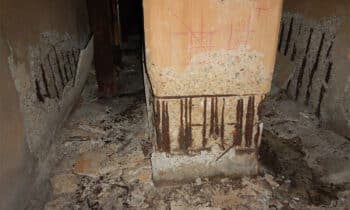
Concrete repair to machine foundations at Dutch steelmaker
The machine foundations under Continuous Casting Machine 21 in the Oxy Steel Plant 2 at the Tata Steel site in Velsen-Noord were struggling with concrete damage (printed concrete) and even diameter reduction of the reinforcement. Consultancy and engineering firm Nebest B.V. was called in to determine the cause of the damage, draw up a repair plan and supervise the renovation work. Tata Steel has indicated that it wants a sustainable recovery, in which new damage must be kept to a minimum for at least the next few decades. Wherever possible, existing concrete components should be retained, with minimal remediation and thus a minimum amount of repair material. Bas van Beers, specialist in existing concrete structures at Nebest, updates us on the chosen techniques that include cathodic protection.

Nebest is familiar with the Tata Steel site and was thus also called in to assess the damage to the machine foundations of Continuous Casting Machine 21. "There was printed concrete due to corroding reinforcement, which was even exposed in many places," Van Beers recalls. "An initial visual inspection further revealed the necessary cracks and diameter reduction of the reinforcement. Enough reasons, therefore, to conduct further destructive testing to determine the cause of the damage. So we drilled cores and examined them in detail."

High chloride content
Nebest's further investigation revealed that the concrete damage was caused primarily by chloride-initiated reinforcement corrosion and secondarily by carbonation-initiated reinforcement corrosion. "The chloride content was high to locally very high and penetrated during the use phase," Van Beers explained. "Based on the results from our analysis, we issued a recommendation, prescribed measures and performed a structural consideration. There was no immediate danger to the structural safety of the structure. We then prepared an executive budget and project specification (specifications). The high chloride content was leading for the choice of concrete repair and additional protective measures." Nebest then assisted Tata Steel in the contractor selection and is currently providing guidance and monitoring during the renovation work.

Cathodic protection
The concrete repair is being performed in three phases, in accordance with BRL 3201 and CUR Recommendation 118. "Each phase is being re-licensed," says Van Beers. "We are currently working on phase 2 with the same contractor who also performed phase 1. While phase 1 was characterized by high temperatures, high humidity and working in confined spaces, in phase 2 it is mainly the many existing pipes and tubes that complicate the concrete repair as they cannot be dismantled." For both phases, Nebest recommended applying cathodic protection by impressed current on the reinforcement. "This form of corrosion protection affects the electrochemical corrosion process. Direct current is conducted through anodes in the concrete, from the concrete to the reinforcement and via cables back to the power supply. Here, the reinforcement functions as the cathode and the external electrode as the anode in an electrochemical cell," Van Beers clarified. "An advantage of cathodic protection is that you do not have to remediate concrete damage and clean reinforcement as intensively as with traditional concrete repair. Given the limited space and pipes present, that is definitely an advantage here. This form of concrete repair is also much more sustainable. And that also fits within the requirements set by Tata Steel for the most sustainable and low environmental impact recovery possible."


Phase 2 is currently being finalized. The next phase will most likely be licensed next year. Even in the third and final phase, Nebest will undoubtedly keep a tight rein on the reins, so that Tata Steel is guaranteed a high-quality end result.
Heeft u vragen over dit artikel, project of product?
Neem dan rechtstreeks contact op met Nebest BV.
 Contact opnemen
Contact opnemen




